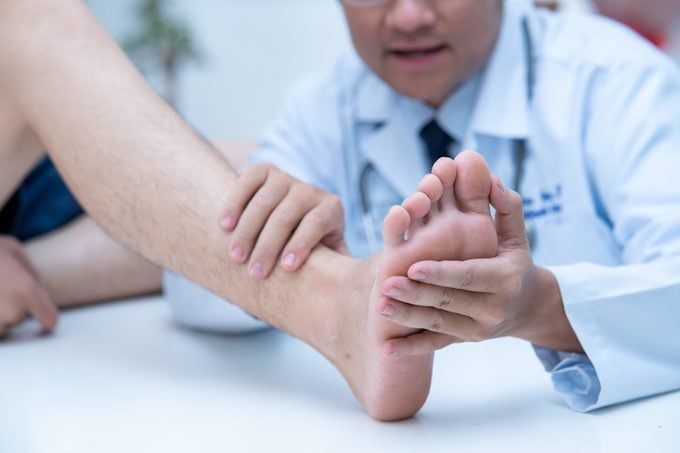9 Proven Treatments for Stasis Dermatitis
Updated: May 20, 2021
Poor vein circulation in your lower legs can lead to swelling and itchiness—called stasis dermatitis. Learn what you can do to relieve your symptoms.

Don’t stand or sit around too long
“Stasis dermatitis is caused by poor vein circulation in the lower legs,” says Melanie Palm, MD, a board-certified dermatologist and cosmetic surgeon at Art of Skin MD, in San Diego. The National Eczema Association says symptoms include swelling, scaling and dryness, leg aches and redness; more severe cases may involve oozing and infection. Unfortunately, a common habit may make intensify the problem, says Dr. Palm. “Excessive standing or sitting could worsen the condition.” Help your body recover from a day of sitting by following these easy steps.
Get moving
Exercise has benefits for stasis dermatitis patients, too. “I counsel my patients that wherever they are, they should be pumping their legs and doing calf raises,” says Mohiba Tareen, MD, a board-certified dermatologist at Tareen Dermatology in Roseville, MN. “This helps the veins pump the blood back to the heart. You will often see me standing in line at the grocery store or speaking on the phone and doing my ‘covert’ leg exercises to prevent leaky veins!”
Try compression hose
“Consistent use of compression hose is essential,” Dr. Palm says. “Thigh-high varieties are far better than knee-high.” She explains that long-term control of stasis dermatitis often involves wearing graduated compression stockings “to help assist the return of fluid from the lower leg back to the circulation.”
Put your feet up
“Get used to sleeping with your legs elevated on several pillows,” Dr. Tareen says. “We sleep for six to eight hours a day and keeping the blood flowing while asleep is a great bonus!” In addition to elevating your feet while you sleep, try these other at-home remedies to reduce foot swelling and improve circulation.
Try some supplements
 “Patients may consider supplementing their diet with rutin and vitamin C, both of which help with overall vein health,” Dr. Palm says. In fact, according to the Vein and Vascular Institute in New Jersey, vitamin C “plays an important role in the production of collagen and elastin, both of which are essential for healthy, elastic blood vessels.” You can find this inflammation-reducing vitamin not only in citrus fruits, but broccoli, berries, potatoes, and tomatoes. There are tons more; these other foods can also boost collagen naturally, too.
“Patients may consider supplementing their diet with rutin and vitamin C, both of which help with overall vein health,” Dr. Palm says. In fact, according to the Vein and Vascular Institute in New Jersey, vitamin C “plays an important role in the production of collagen and elastin, both of which are essential for healthy, elastic blood vessels.” You can find this inflammation-reducing vitamin not only in citrus fruits, but broccoli, berries, potatoes, and tomatoes. There are tons more; these other foods can also boost collagen naturally, too.
Lose weight
Excess weight—especially obesity—can lead to the leaky veins that cause venous stasis dermatitis. To improve blood flow in the legs, NYU Langone Health suggests walking, jogging for 30 minutes several times weekly, or riding a stationary bike. You’ll boost blood flow but may also shed some pounds in the process.
Slather on the moisturizer
“My main message to individuals with stasis dermatitis is to moisturize and keep the skin healthy with simple topicals with few allergens such as Vaseline, Vanicream, or Cerave products,” Dr. Tareen advises. For starters, try these all-natural moisturizers you probably already have in your house. “If the itch is still not going away, judicious use of topical steroids under the direction of your doctor may help.”
Watch out for foods that cause you to retain fluids
Foods that are high in sodium can cause you to retain water. For example, fast food and processed foods like lunch meat, crackers, chips, canned vegetables, and soups may all be fluid-retaining culprits. Take some tips from the Mayo Clinic. They suggest trying flavorful sodium alternatives such as spices and herbs. Additionally, they recommend becoming label savvy, noting that monosodium glutamate (MSG), baking soda, and sodium nitrate are just a few of the salt or sodium-containing compounds to watch out for. While sodium remains a key factor behind fluid retention, it’s not necessarily the only reason; here are some other causes behind water weight.
Try laser therapy
To heal your stasis dermatitis treatment permanently, medical intervention may be necessary. “The real cause is the deep veins that have become incompetent over time,” Dr. Tareen says. “The skin is really an ‘innocent bystander’ that becomes inflamed and ulcerated from the chronic pressure of the leaky veins. Thus all therapy must be directed at the root cause—fixing the veins. There are great advances in laser therapy for incompetent deep veins.”


















